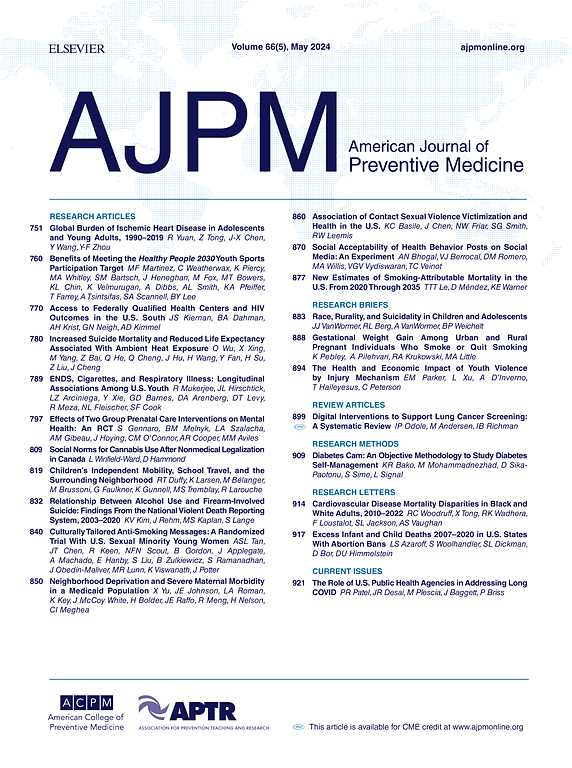Injuries From Electric Bikes and Scooters: Illinois, U.S., 2021–2023
IF 4.5
2区 医学
Q1 MEDICINE, GENERAL & INTERNAL
引用次数: 0
Abstract
Introduction
Micromobility device injuries and deaths continue to increase in the U.S., requiring public health input. The aim of this study was to describe injuries from micromobility devices in the state of Illinois and to determine whether there are differences in the patterns and severity of injuries from the use of electric devices (scooters/bikes) to inform future public health policy.
Methods
Outpatient and inpatient acute traumatic injuries related to micromobility device use that passed through the emergency room and were treated in Illinois hospitals from 2021 to 2023 were analyzed in 2024 using newly introduced ICD-10 codes for injuries resulting from electric scooters and other devices.
Results
Of 34,073 patients presenting with acute injuries from micromobility devices, the nature, severity, and mechanism of injuries differed for electric devices. Electric scooter injuries primarily occurred owing to falls (78.4%), whereas nearly half (45.4%) of electric bike injuries were caused by motor vehicle crashes (in traffic, nontraffic, or unspecified). Using cycling injuries as a reference group, users of electric devices were significantly more likely to be admitted to hospital (electric bikes AOR=1.62, p<0.05; electric scooters AOR=1.61, p<0.01), to be admitted to the intensive care unit (electric bikes AOR=2.39, p<0.01; electric scooters AOR=2.04, p<0.01), and to present with a traumatic brain injury (electric bikes AOR=1.3, p<0.05; electric scooters AOR=1.23, p<0.01).
Conclusions
Statewide hospital data demonstrate an increased likelihood of serious injuries associated with electric micromobility device use, relative to bicycles. These findings have implications for ongoing surveillance and safety promotion and further demonstrate the need for public health input into the use of personal electric micromobility devices in the U.S.
电动自行车和踏板车造成的伤害-伊利诺伊州,美国,2021-2023。
背景:在美国,微活动装置造成的伤害和死亡持续增加,需要公共卫生投入。本研究的目的是描述伊利诺伊州微型移动设备造成的伤害,并确定使用电动设备(踏板车/自行车)造成的伤害模式和严重程度是否存在差异,从而为未来的公共卫生政策提供信息。方法:采用新引入的ICD-10电动滑板车和其他设备造成的损伤代码,对2021-2023年伊利诺伊州医院急诊室收治的门诊和住院患者与使用微动装置相关的急性创伤性损伤进行分析。结果:在34,073例因微活动装置引起的急性损伤患者中,电子装置的损伤性质、严重程度和机制存在差异。电动滑板车的伤害主要是由于跌倒(78.4%),而近一半(45.4%)的电动自行车伤害是由机动车碰撞(交通事故、非交通事故或未指明事故)造成的。以骑自行车受伤作为参照组,使用电子设备的人入院的可能性明显更高(电动自行车的or为1.62,p≤0.05,电动滑板车的or为1.61,p)。结论:全国范围内的医院数据显示,与骑自行车相比,使用电动微移动设备发生严重伤害的可能性增加。我们的研究结果对正在进行的监测和安全推广具有启示意义,并进一步证明了在美国,公共卫生部门需要投入到个人电动微移动设备的使用中。
本文章由计算机程序翻译,如有差异,请以英文原文为准。
求助全文
约1分钟内获得全文
求助全文
来源期刊

American Journal of Preventive Medicine
医学-公共卫生、环境卫生与职业卫生
CiteScore
8.60
自引率
1.80%
发文量
395
审稿时长
32 days
期刊介绍:
The American Journal of Preventive Medicine is the official journal of the American College of Preventive Medicine and the Association for Prevention Teaching and Research. It publishes articles in the areas of prevention research, teaching, practice and policy. Original research is published on interventions aimed at the prevention of chronic and acute disease and the promotion of individual and community health.
Of particular emphasis are papers that address the primary and secondary prevention of important clinical, behavioral and public health issues such as injury and violence, infectious disease, women''s health, smoking, sedentary behaviors and physical activity, nutrition, diabetes, obesity, and substance use disorders. Papers also address educational initiatives aimed at improving the ability of health professionals to provide effective clinical prevention and public health services. Papers on health services research pertinent to prevention and public health are also published. The journal also publishes official policy statements from the two co-sponsoring organizations, review articles, media reviews, and editorials. Finally, the journal periodically publishes supplements and special theme issues devoted to areas of current interest to the prevention community.
 求助内容:
求助内容: 应助结果提醒方式:
应助结果提醒方式:


